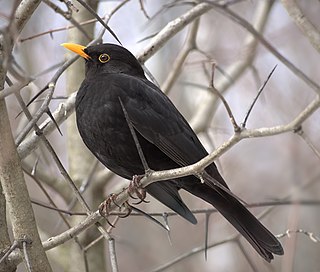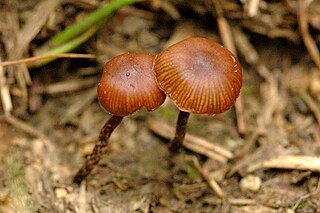
A parakeet is any one of many small- to medium-sized species of parrot, in multiple genera, that generally has long tail feathers.

True thrushes are medium-sized mostly insectivorous or omnivorous birds in the genus Turdus of the wider thrush family, Turdidae. The genus name Turdus is Latin for 'thrush'. The term thrush is used for many other birds of the family Turdidae as well as for a number of species belonging to several other families.

Pheidole is a genus of ants that belongs to the ant subfamily Myrmicinae. The genus is widespread and ecologically dominant. It probably includes more than 1000 species. The genus first evolved in the Americas, eventually spreading across the globe.

Deconica inquilina is a species of mushroom in the family Strophariaceae. Formerly a member of the genus Psilocybe, this species belonged to the non-blueing (non-hallucinogenic) clade and was consequently moved to Deconica in 2009.
Myrmecia inquilina is a species of ant endemic to Australia in the subfamily Myrmeciinae, first discovered in 1955 and described by Athol Douglas and William Brown Jr. in 1959. These ants are large, measuring 21.4 millimetres (0.84 in). During the time of its discovery, Douglas and Brown announced M. inquilina as the first social parasite among the primitive subfamilies, and today it is one of the two known Myrmecia species to have no worker caste. Two host species are known, Myrmecia nigriceps and Myrmecia vindex. Aggression between M. inquilina and its host species does not occur, and colonies may only produce M. inquilina brood months after the inquiline queens begin to lay their eggs. Queens eat the colony brood or trophic eggs, and other Myrmecia species may kill M. inquilina queens if they reject them. Due to its restricted distribution and threats to its habitat, the ant is "vulnerable" according to the IUCN Red List.

Pheidole inquilina is a species of ant in the genus Pheidole. It is endemic to the United States.
Conchodus is an extinct genus of marine lungfish which lived during the Devonian period.

Campanella is a genus of fungi in the family Marasmiaceae. The genus has a widespread distribution, especially in tropical regions, and contains about 40 species.

Deconica is a genus of mushroom-forming fungi in the family Strophariaceae. It was formerly considered synonymous with Psilocybe until molecular studies showed that genus to be polyphyletic, made of two major clades: one containing bluing, hallucinogenic species, the other non-bluing and non-hallucinogenic species. Deconica contains species formerly classified in the sections Deconica and Coprophila of Psilocybe.
Anabremia inquilina is a gall midge and a member of the genus Anabremia. This species was first described from Italy in 1965. It is an inquiline of another gall midge - Jaapiella medicaginis - which makes galls on Medicago species.

Alphestes is a genus of marine ray-finned fish, groupers from the subfamily Epinephelinae in the family Serranidae, which also includes the anthias and the sea basses. Alphestes species are found in the western Atlantic Ocean and the eastern Pacific Ocean.

Myrmecia regularis is a species of ant endemic to Australia. A member of the genus Myrmecia in the subfamily Myrmeciinae, it was first described by American entomologist Walter Cecil Crawley in 1925. These ants are medium to large in size, measuring 10 to 20 millimetres, and they are bright brownish-red in colour. Queens and workers share similar morphological features, but they can be distinguished by the noticeable size difference. Males also look similar, but collected specimens are too damaged to be examined properly.

Diplozoidae is a family of monogeneans in the order Mazocraeidea. In all species of this family, the bodies of the two hermaphroditic members of a couple are permanently fused for life. These monogeneans are parasitic on the gills of freshwater fish.

Gastrocotylidae is a family of polyopisthocotylean monogeneans. All the species in this family are parasitic on fish.

Panscopus is a genus of broad-nosed weevils in the beetle family Curculionidae. There are more than 30 described species in Panscopus, found in North America.

Eirenidae is a family of hydrozoans.

Philoscia is a genus of woodlice in the family Philosciidae. There are more than 80 described species in Philoscia.

Amarochara is a genus of beetles belonging to the family Staphylinidae.

Exoneura is a genus of social bees belonging to the taxonomic family Apidae. This genus has glossy black head and thorax with a black or red-orange abdomen. The species of this genus are found only in Australia, often in small burrows they dig up themselves. Members of this genus are generally 8 millimeters (mm) in length. This species is parasitized by members of the genus Inquilina. This relationship with Inquilina has been going on for approximately 15 million years.
Isela inquilina, originally described as Kilifia inquilina, is a species of true spider in the family Mysmenidae. The species is endemic to Kenya and was first described by L. L. Baert and J. A. Murphy in 1985.















